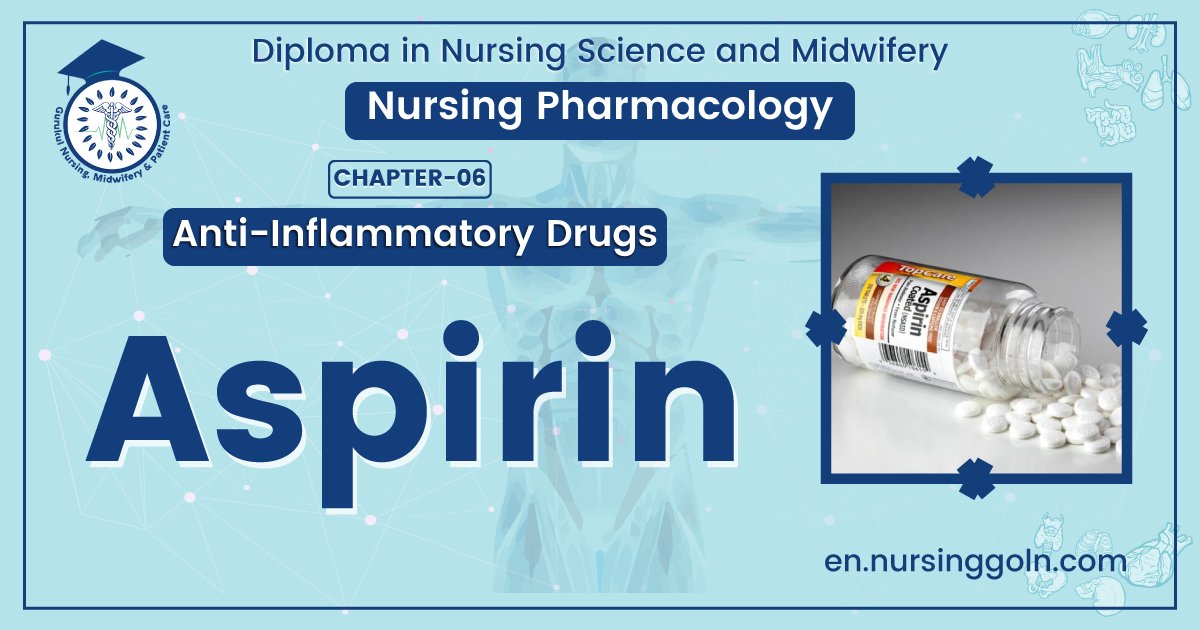Acetyl-Salicylic Acid ( Aspirin ) – This book covers the entire syllabus of “Pharmacology” prescribed by BNMC- for a diploma in nursing science & midwifery students. We tried to accommodate the latest information and topics. This book is an examination set up according to the teachers’ lectures and examination questions.
At the end of the book, previous questions are given. We hope in touch with the book students’ knowledge will be upgraded and flourish. The unique way of presentation may make your reading of the book a pleasurable experience.

Acetyl-Salicylic Acid ( Aspirin )
➤ Source: Natural: willow bark-as bitter glycoside salicin and oil of wintergreen.
➤ Chemical nature: Weak organic acid.
As-pirin is the initial drug of choice for treating the majority of articular (arthritis) and musculo-skeletal disorders.
Mechanism of action of Aspirin:
| As-pirin inhibits prostaglandin synthesis. This is bought about by the following ways: Aspirin (salicylates) ↓ |
Acetylates the a-amino group of the terminal serine of the cyclo-oxygenase enzyme; forming a covalent bond ↓ Irreversible inactivation of cyclo-oxygenase enzyme ↓ Prostaglandin synthesis is arrested ↓ Analgesics response ↓ Anti-inflammatory response Anti-pyretic response ↓ Anti-platelet response |
Pharmacological action of Aspirin
The principal effects of as-pirin are:
1. Anti-inflammatory action (PNS effect)
2. Analgesic action (CNS & PNS effect)
3. Anti-pyreric: action (CNS effect)
4. Anti-platelet (prevent platelet aggregation, PNS effect)
5. Other actions of As-pirin:
Effects of aspirin on acid-base and electrolytes balance
As-pirin stimulates respiratory center: Hyperventilation. Mechanism:
1. As-pirin directly stimulates respiratory center and chemoreceptors > increase rate and volume of respiration.
2. Aspirin increase 02 consumption causes CO2 accumulation stimulates chemoreceptor indirectly > increase rate and volume of respiration
As a result, respiratory alkalosis develops
3. This is compensated by increased renal excretion of HCO3″ with Na+, K+ & water. So, it is called compensated respiratory alkalosis.
Indication of Aspirin
Systemic uses:
1. To relieve mild to moderate pain (non-visceral):
◆ Headache
◆ Toothache
◆ Migraine
◆ Myalgia
◆ Arthralgia
◆ Dysmenorrhoea
◆ Osteoarthritis
2. As anti-pyretic: to reduce fever.
3. As Anti-Rheumatic and Anti-inflammatory agent:
◆ Acute Rhetrmatic fever
◆ Ankylosing spondylosis
◆ Osteoarthritis
◆ Acute Rh-arthritis
◆ Acute and chronic glomerulonephritis
4. anti-thrombic agent:
◆ Cerebrovascular accident
◆ Venous thrombosis
◆ Pulmonary embolism 102
◆ Atherosclerotic disease
◆ Coronary thrombosis
◆ Myocardial infarction
◆ Postoperative deep vein thrombosis
5. Local uses: as-
◆ Antiseptic
◆ Fungicidal &
◆ Keratolytic agent
6. Other uses:
◆ Primary dysmenorrhea
◆ Patent ductus arteriosus
◆ Bartter’s syndrome

Recent uses: in-
1. Cholera: Vibrio cholerae release PG which increase GIT motility (loose motion). But as-pirin blocks this synthesis, thus prevents cholera.
2. Infertility: As-pirin may helps in sperm synthesis.
Cardiovascular indications of Aspirin
1. Acute myocardial infarction.
◆ Loading dose: 300 mg
◆ Maintenance dose: 100-150 mg
2. Acute rheumatic fever.
◆ Dose: 75-100 mg/kg body weight/day.
3. Acute pericarditis.
4. Prophylaxis of arterial thromboembolism.
Contraindication of Aspirin
1. Peptic ulcer
2. Patient with bleeding disorders
3. Hepatic and renal disease
4. Pregnancy (last trimester)
5. Asthma
6. Gout
7. Patient intolerance to as-pirin
Adverse effect of Aspirin
1. Gastric and duodenal ulceration.
2. Bleeding tendency (impaired clotting)
3. Renal irritation.
4. Tinnitus, deafness (overdose)
5. Reye’s syndrome
6. Iron deficiency anaemia.
7. Allergic manifestations:
◆Severe rhinitis
◆ Urticaria
◆ Angioneurotic oedema
Dose of Aspirin
A. Normal dose: 300 mg 8-hourly (900 mg/day).
B. In Rh-Fever: 50 mg/kg/day (3000 mg/day of 60 kg man)
C. In Rh-Arthritis: 4-6 mg/day.
(N.B.: to avoid gastric side effect: As-pirin is taken with a glass of water or milk or taken after meal or with antacid).
Aspirin overdose (Salicylism)
- Salicylate intoxication: When salicylate is taken >8 gm/day.
- Types: two types mild and severe.

Salicylism
Mild type of chronic intoxication by salicylate is called Salicylism. Salicylism is a series of reaction frequently recurring when the thererapeutic dose of aspirin is high, e.g. used in Rh-fever and Rh-arthritis. This occurs when plasma level of salicylate exceeds 25 mg/100ml.
Clinical features of Salicylism
Mild intoxication: Due to repeated administration of large dosage
A. GIT: Nausea, vomiting, diarrhoea.
B. CNS: Headache, dizziness, mental confusion
C. Respiratory: Tachypnoea, respiratory alkalosis.
D. Others: Sweating, thirst, hyperpyrexia, tinnitus. Vertigo, Petechial haemorhage, Defective vision and hearing
Severe intoxication:
- Hallucination
- Vertigo
- Delirium confusion-coma
- Skin eruption
- Acid-base balance abnormalities
Treatment of Salicylism
- Withdraw of medication and hospitalization.
- Induce vomiting or gastric lavage.
- Activated charcoal to prevent aspirin absorption. to s
- Correction of acidosis by HCO or forced alkaline diuretics
- Correction of fluid and electrolytes balance.
- Correction of hyperthermia by ice-blankets or sponging of body.
- Blood transfusion (if necessary).
- Haemodialysis to remove salicylate from blood.
Reve’s syndrome:
There is moderately strong evidence that aspiring is a cause of rare Reye’s syndrome (a form of encephalopathy, liver injury) in children and teenagers recovering from febrile viral infections (respiratory, varicella). Paracetamol is preferred for such febrile illness.
Pharmacokinetics of aspirin
1. Routes of administration: Oral (buffer, soluble, effervescent. enteric coated tablets), parenteral
2. Absorption: Well absorbed from stomach and upper gastrointestinal tract (GIT).
3. Distribution: Highly protein bound.
4. Metabolism: Hydrolysis; conjugation with glycine
5. Excretion: Renal (tubular secretion)
Morphine VS aspirin as analgesic agent:
| Points | Morphine | Aspirin |
| source | Natural: From opium alkaloid. | Willow bark |
| Site of action | CNS | CNS and PNS |
| Mechanism of action | Receptors mediated action; causing hyperpolarisation, postsynaptic inhibition & inhibit presynaptic neurotransmitter release | Inhibit PG synthesis by irreversible inhibition of enzyme cycloxygenase |
| Used in | Severe types of Pain (visceral origin) | Mild to moderate pain (MSK pain) |
Associated effect
| No No No | No No No |
| Marked Marked | Negligible Negligible |
| Anti-inflammatory | Anti-pyretic | Anti-platelet |
Read more:
